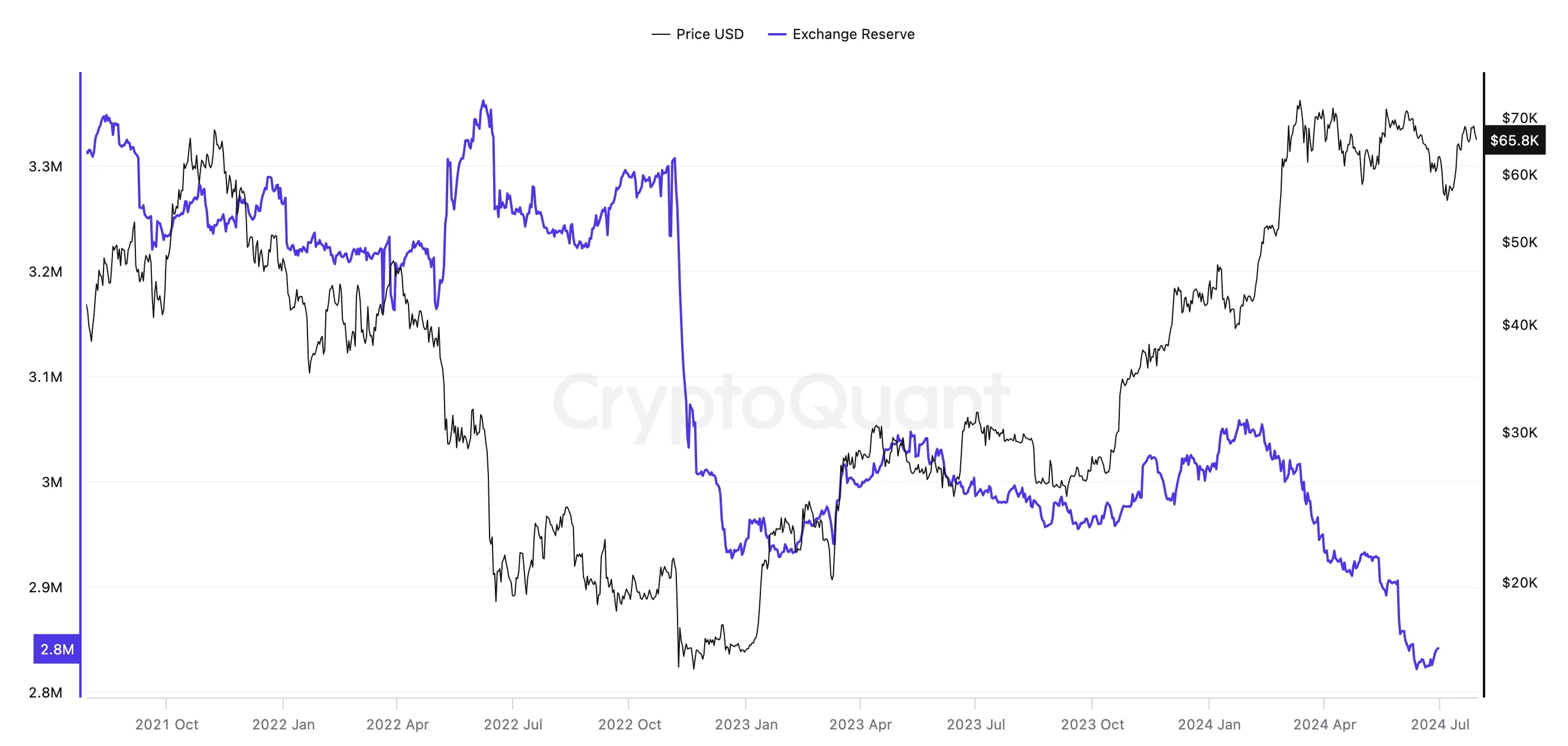
Bitcoin exchange reserves have plummeted to approximately 2.8 million coins—their lowest levels in years.
This sharp decline comes amid a sustained price surge from Bitcoin as it keeps testing $70,000, according to data from on-chain analytics platform CryptoQuant.
This significant decline in exchange reserves comes at a time when Bitcoin's price is roughly 10% away from its all-time high price of $73,737, according to CoinGecko data. Bitcoin is trading at $66,700 as of writing.

The trend of decreasing exchange reserves began in early 2022 and has accelerated notably over the past year. However, the chart shows a slight reversal in this trend over the last month, with a small increase in reserves that potentially indicates a short-term shift in investor behavior or increased trading activity.
The uptick correlates with recent uncertainty over Bitcoin movements, analysts say, including the long-awaited Mt. Gox Bitcoin releases, sales by the German government, or potential sales by U.S. government agencies of seized cryptocurrencies. These high-profile cases have the potential to introduce substantial amounts of previously dormant Bitcoin back into circulation.
The divergence between rising prices and falling exchange reserves has caught the attention of market analysts and investors.
Bitfinex analysts told Decrypt that exchange reserves tend to correlate with the amount of assets the participants choose to store on an exchange—and might potentially sell or trade. Conversely, assets stored off an exchange tend to be held by investors for investment purposes or as a store of value.
"Looking at the chart, we can see that the spot Bitcoin reserves is decreasing constantly,” the analysts wrote. “This could mean that the traders are of the belief that a bottom is in sight and are looking to store their coins offline for holding it for the long term.”
Generally speaking, the amount of crypto assets stored on exchanges has an inverse relationship the the price. When one goes up, the other is probably going down—and vice versa, said Adam Berker, senior legal counsel at global payments infrastructure platform Mercuryo.
"Typically, an increase in the amount of crypto indicates that people are preparing to sell, which is why they deposit their Bitcoin on the exchanges,” Berker said. “On the other hand, when the amount of crypto on exchanges decreases, it suggests that people are less inclined to sell. Instead, they transfer their BTCs to cold wallets and custodial wallets and keep them in long-term storage.”
While Bitcoin's price experienced substantial growth throughout 2023 and into 2024, the amount of Bitcoin held on exchanges has steadily declined, reaching levels not seen since 2018.
Noting an additional nuance, Bitfinex analysts state, "We can also see that the exchange reserves even for the derivatives exchange [are] generally decreasing, with the slight uptick attributed to the recent volatility seen."
The current situation starkly contrasts with late 2022, when exchange reserves saw a sharp spike coinciding with a major price downturn. Since then, the relationship between price and exchange reserves has inverted, with reserves declining as prices climb.
Shimon Lazarov, chief marketing officer at Bitcoin wealth management and secure custody specialists Unchained, told Decrypt that this overall trend reflects not just strong investor confidence in Bitcoin’s future price potential but also a growing awareness of the ever-present risks associated with centralized custodians.
“As Bitcoin’s value continues to increase, we expect more and more investors to prioritize security and control of their assets over convenience, turning to more decentralized custody solutions in an effort to ensure the safety and integrity of their investments long term,” Lazarov said.
Edited by Ryan Ozawa.